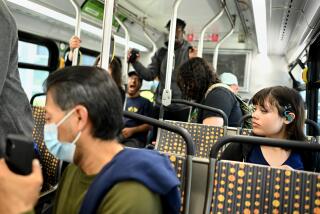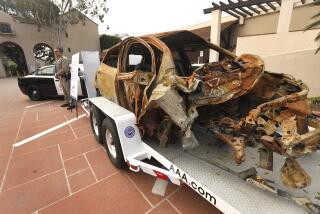Experts Urge Americans to Walk the Walk
- Share via
WASHINGTON — Federal health experts, concerned about America’s love affair with the car, are trying to cool the romance. It’s for our own good, they say.
Americans are not getting enough healthy physical activity, and would be better off if walking or biking were a bigger part of daily life, the experts say.
One way to get Americans on their feet is to get them out from behind the wheel.
“Nationally, 7% of all trips are nonmotorized,” said health scientist Rich Killingsworth of the Centers for Disease Control and Prevention in Atlanta. “We’d like to see that double to 14% over 10 years.” The percentage of motorized trips would have to drop commensurately, he said.
Think it can’t be done? The CDC scientists are more optimistic. They note that many Americans have learned to quit smoking and curb their tastes for fatty foods, thereby reducing their risks of lung cancer and heart disease.
The experts figure that, if government nagging can help Americans to control addiction and appetite, then encouraging them to go for a nice walk or a bike ride isn’t too much to expect.
The research groundwork has been laid. Exercise scientists have found that moderate activity--the energy equivalent of brisk 30-minute walks five days a week--can lift adults out of the sedentary category that carries the highest risk for premature death. The agency believes sedentary living is a primary factor in at least 200,000 deaths a year from heart disease, cancer and diabetes.
Those findings underlie CDC’s exercise guidelines, which call on Americans to do at least that much activity by walking, biking, gardening, housework or whatever else fits their lives. If one half-hour is inconvenient, the activity can be split into blocks of about 10 minutes each, the guidelines say.
Americans don’t seem to be listening. Eighty percent of American adults don’t get their 30 minutes, CDC figures show. But what Americans don’t do voluntarily as exercise might be done if it’s hardwired into normal living, the health officials hope. So researchers and policy experts are studying community design and lifestyle preferences that keep people wedded to their cars.
Community life is another exercise issue. Parents prefer to have children bused to school rather than walk because the parents are afraid something bad could happen to children who walk, Killingsworth said. “Most of that is based upon myth,” he said. “Most communities are safe.”
To get kids more active, CDC is developing a formal Walking School Bus program. In it, parents and children will plan safe routes to school or a distant bus stop, with parents escorting the children to school in groups.
And CDC is funding preparation of a planning manual by the Bicycle Federation of America. Roads should be lined with bike lanes and sidewalks as a matter of course, Killingsworth said.
Whether Americans would give up their cars even under optimal conditions is an unknown.
At the American Automobile Assn. headquarters in Heathrow, Fla., staffers are dubious. People are unlikely to lug bags of groceries home without a car, a AAA spokesman said.






